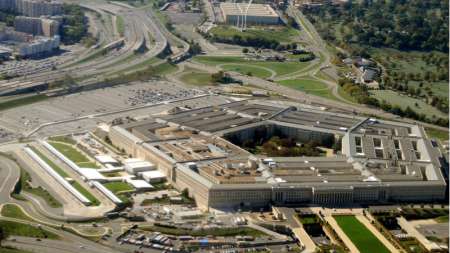The Defense Department’s (DoD’s) Joint Regional Security Stacks (JRSS) have not met the regional security implementation expectations of DoD’s Joint Information Environment (JIE), according to a June 4 public Office of Inspector General (OIG) report. […]
The American Federation of Government Employees (AFGE) filed an unfair labor practice complaint against the Department of Defense (DoD) on behalf of the Defense Contract Management Agency (DCMA), alleging that the Pentagon neglected its duty to consult with the union on 1,200 IT personnel transfers to the Defense Information Services Agency (DISA). […]
The co-founders of the Senate Artificial Intelligence Caucus, Sens. Martin Heinrich, D-N.M., and Rob Portman, R-Ohio, introduced the Armed Forces Digital Advantage Act on May 16. […]
The Department of Defense (DoD) is soliciting submissions for construction manufacturing that can be done autonomously. The proposed technology should be able to construct barracks, houses, and other buildings, along with mobility and counter-mobility tools like bridges, culverts, and anti-vehicle obstacles. […]
With the Department of Defense focused on artificial intelligence (AI) to support the warfighter, cloud computing will be a big part in getting tools out to the tactical edge, said Dana Deasy, CIO of the department, at GDIT Emerge on April 23. […]
Dana Deasy, CIO of the Department of Defense, provided an update on the progress at the Joint Artificial Intelligence Center (JAIC) at GDIT Emerge today, including the initial project with a production version out to the service branches. […]
Secretary of State Mike Pompeo said that a cyberattack could, “in certain circumstances, constitute an armed attack under Article 5 of the U.S.-Japan Security Treaty,” and that the United States would defend Japan in that circumstance. […]
Defense Department (DoD) officials today underscored the importance of the agency’s ongoing electronic health records (EHR) modernization efforts at a Senate Appropriations Committee Defense Subcommittee hearing on the Defense Health Program FY2020 budget request. […]
The Defense Health Agency (DHA), which enables the military to provide medical services to combatant commands during both peacetime and wartime, has migrated to the cloud. […]
The Government Accountability Office (GAO) last week issued recommendations on how the Department of Defense (DoD) can better go about implementing the position of Chief Management Officer (CMO) – a position that took ten years to fill with a confirmed appointment after it was approved by Congress in 2008. […]
Artificial intelligence (AI), following on the heels of its older sibling RPA (robotic process automation), is no longer waiting to be born, but remains more of a toddler on the Federal IT scene–still learning to walk before trying to run, but bulking up from an appetite for serious Federal government tech interest and investment. […]
The Defense Department’s FY 2020 budget proposal which was included as part of President Trump’s budget proposal rolled out yesterday, calls for a total of $9.6 billion of cyber spending, up more than $1 billion from the $8.5 billion DoD cyber spending total cited by the White House in FY2019 budget documents. […]
The National Security Agency (NSA) and the Trusted Computing Group (TCG) industry consortium have come up with validation software that can be used with any device and could go a long way to securing the supply chain for computing devices. […]
Government-wide security clearance processes, and the half million-plus backlog in the clearance applications pipeline, made the Government Accountability Office’s (GAO) High-Risk report last week as a contributing factor to the larger problem of ensuring IT security, generally. […]
Software-maker trade group BSA sent a letter to leaders of the House and Senate Armed Services Committees on Thursday urging modernization of the Department of Defense’s (DoD) supply chain security and software acquisition approach in the FY 2020 National Defense Authorization Act. […]
The Government Accountability Office said in Feb. 25 report that the Defense Department needs to get a better handle on its very considerable weapons systems software sustainment costs, which it estimated may run at least $15 billion over the next five years. […]
Senior Defense Department officials told House members on Tuesday they are taking additional steps to boost cybersecurity workforce ranks at the Pentagon through means including the Cyber Excepted Service (CES) personnel system authorized in 2016 that allows DoD to expedite and simplify recruiting and hiring for civilian cyber professionals. […]
Defense Department (DoD) officials voiced sometimes conflicting ideas today about how the agency should migrate legacy systems to the cloud. […]
The Department of Defense’s Artificial Intelligence Strategy puts the DoD on more of a fast track toward developing and employing AI and machine learning to support, as the strategy’s preface states, “a force fit for our time.” The strategy outlines an accelerated, collaborative approach with industry, academia, and allies toward new technologies that will “transform […]
The Department of Defense’s recently released Cloud Strategy covers a lot of territory, from an emphasis on the multibillion dollar Joint Enterprise Defense Initiative as a foundation of its plans, to its description of seven strategic objectives it wants to achieve in the cloud. One of those objectives is to extend tactical support to warfighters at the network edge to give units in the field the technology and tactical information they need to operate in a battlefield where seamless communications are essential and where cyber operations and electronic warfare are an increasingly important factor. […]
The call last week by the Pentagon’s top tester to temporarily halt deployment of the Department of Defense’s Joint Regional Security Stacks (JRSS) wasn’t exactly out of the blue. The DoD’s independent Director of Operational Test and Evaluation (DOT&E) said the same thing in its annual report last year, while citing some of the same problems, such as staffing shortages, difficulty in integrating disparate commercial technologies, and the lack of mature standard operating processes. […]
The Department of Defense Cloud Strategy released this week emphasizes the importance of the Joint Enterprise Defense Initiative (JEDI) cloud contract in the computing environment of the Pentagon. […]
On Tuesday, President Trump continued to push his desire for a border wall on the U.S.- Mexico border, even suggesting a “human wall” to prevent immigrants from illegally entering the U.S. President Trump will give his State of the Union address tonight where he could talk about border security at length. […]
In a report released yesterday by the Department of Defense’s (DoD) Office of the Director of Operational Test and Evaluation (DOT&E), missions and systems remain at risk from adversarial cyber operations with operational testing discovering vulnerabilities that are considered mission critical. […]
Department of Defense (DoD) and private sector leaders gathered to discuss the state of cybersecurity in the U.S. military during a Tuesday Federal Executive Forum webinar. […]
A trio of Defense Department IT heavyweights told senators at a Jan. 29 hearing that the agency is tightly focused on implementing the cybersecurity strategy it unveiled last year, and they expressed a high degree of confidence that their efforts in 2019 to implement that strategy will drive security improvements. […]
If recent events are any indication, we could be seeing big changes to agency cloud migration plans in 2019. The Federal government could be rethinking its role in owning and operating its own data centers, strongly questioning whether that is a job best left to government employees. […]
According to an internal evaluation report, the Department of Defense’s (DoD) Joint Regional Security Stacks (JRSS) program is behind schedule, undermanned, full of cybersecurity issues, and should be discontinued until the system demonstrates that it can assist network defenders in detecting and responding to cyberattacks. […]
From a cybersecurity perspective, the strengths of artificial intelligence (AI) and machine learning (ML) are also weaknesses. The capacity to crunch massive amounts of data, identify patterns, and learn while working covers a lot of territory, but also leaves room for vulnerabilities, which Pentagon and Intelligence Community (IC) researchers want to close up. And the job doesn’t look easy. […]
The Department of Defense (DoD) has put a lot of emphasis on speeding up the acquisition and development of new technologies out of a need to keep pace with new advances and potential adversaries. But a new report from the Government Accountability Office (GAO)–evaluating the Army Futures Command modernization effort–throws in a word of caution, saying there is such a thing as going too fast. […]





















